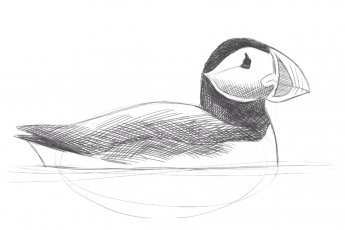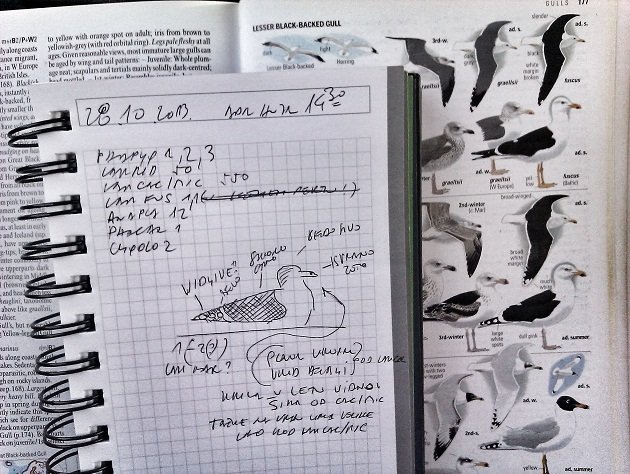There’s really no more quintessentially southeastern bird than the Pine Warbler. You can argue that large waders of Florida are flashier or that the secretive Bachman’s Sparrow elicit more respect, and sure, Pine Warblers nest as far north as southern Canada so how can they really be southeastern, but if you raise these points I think you fail to realize how truly prolific Pine Warblers are in the south. They are everywhere and any time of the year. They start singing in my neighborhood in February, and they continue right on up to July when they suddenly seem to disappear, only to reappear in fall buoyed by what always seems to be a remarkably successful mating season.
In October our resident Pines are supplemented by birds from farther north resulting in actual factual flocks of Pine Warblers congregating in pine stands and parks anywhere in the Piedmont of North Carolina and undoubtedly across the entire region. Few regions on the continent really get to see Pine Warblers in these sorts of numbers, and birders in the fall get to see a lot of them. In fact, just yesterday I visited a spot where Pine Warblers are abundant year round, but on this particular day there were more Pine Warblers than I remember seeing in a long time. Better, the birds were in every conceivable plumage from burnished gold adult males to largely featureless first year females.
I was fortunate, in that I knew that the vast majority of birds in front of me, at least those that weren’t Palm Warblers or Yellow-rumped Warblers, were all Pines. But that’s not a luxury all birders in the east have. Because depending on the angle and the light Pine Warblers have the rather unusual distinction of appearing to look like nearly every single other species of migratory passerine in eastern North America. They are a chimera bird with the ability to raise hopes and dash dreams in seconds. And when you spend enough time down here you end up looking at lots of Pine Warblers thinking for seconds or minutes that they might be something else. But they almost never are. They’re always variations on the Pine Warbler theme.
All of the following photos were taken at Ebenezer Point on Jordan Lake in Chatham County in about an hour. And they are all Pine Warblers.

The classic Pine Warbler is a largish, heavy-bodied warbler with a pair of bold wing-bars and a broken eyering. Beyond that, they can have breast streaks or no breast streaks, and all points in between. They can be entirely golden across the belly or show no yellow at all, and all points in between. You might be amazed at how these basic field marks can be organized to make one bird look rather different than another, but you just haven’t seen enough Pine Warblers. They don’t all look like the super bright, plain-breasted dude above, unfortunately.

When one includes Pine Warblers in the ID conundrum pantheon, it’s usually alongside a pair of boreal nesting species, the Blackpoll Warbler and the Bay-breasted Warbler. And especially dull young female Pines, like the one above, can look a lot like those two, particularly the latter. But you can still see the more or less obvious eyering and, especially, the massive bill. Pine Warblers are bulky and slow as far as warblers go, not so much like the hyperactive, tiny-billed Baypolls.

But it’s that sluggishness that makes the Pine Warbler appear more like vireos than warblers on occasion. The bird above, a first-fall male, looks remarkably like a juvenile White-eyed Vireo. Note, even, that the bird has a bit of gunk on the tip of its bill that makes the heavy bill look even more like the hook-tipped bill of a vireo. With this to deal with, how can we ever hope to get comfortable with this bird?

Above is another adult male, but one far duller than the bird at the top of the post. The wingbars look a little thin too. I’m just speculating here, but I wonder if our resident Pine molt on a different schedule than the migratory birds. The extent of the wingbars among the myriad birds in the area was extremely variable.

Above is another adult male, this time a bit wet from having just finished bathing in a puddle nearby. Again note the vireo-esque structure, big-headed and bulky. These birds can easily be mistaken for Yellow-throated Vireo if you never see the straight bill.

The above bird – my best guess is an adult female – is not quite as gray as the young females, notable mostly for its lack of overt field marks. You can still see those wingbars, however, faint, and the clean eyering and big bill. It’s this particular plumage that suggests Bay-breasted or Blackpoll Warblers, though, with the faint wash of buffy green on the sides. What I mean to say is that I’ve looked at many many birds like this only to be disappointed.

The classic first-fall female. A little streaky, but mostly plain gray-brown with very little green or yellow. Seen this well it’s not too difficult, but seeing any portion of this sort of bird working its way through a still-leafed tree? Maddening.
Widespread and often frustrating, Pine Warblers are easily the most seen warbler in the southeast this time of year. But no matter how many of them you see, you can be almost certain you never see the same one twice.





 New writers welcome – please contact us for details.
New writers welcome – please contact us for details.

















Thanks for the education, Nate! Now I’m more inclined to nail Pine Warbler as the ID for the mystery warbler I saw a few weeks back. (All I retained were the dull gray back and wings, very pale undercoating, two wing bars, and huge-looking eyes.) Thanks for your help!
Remember this? “A musuem tray of Pine Warblers looks like a catch-all for the museum’s ratty, discarded Warbler skins.”
5/3/2014 this is the first morning this spring i have seen more than one warbler species in my back yard in western massachusetts. usually by now i have seen palm warblers and yellowrumped, but my first warbler this year was a pine and today, another pine along with a yellowrumped and a black and white. neither pine had steaks, but the wingbars and the song- like a chipping sparrow but less insect -like, pinned it down. i usually see just one or two , now that i’m a less aggressive birder. once i see one i don’t go checking out every bird in the high pines that sounds like a chippy, because most of them are around here.